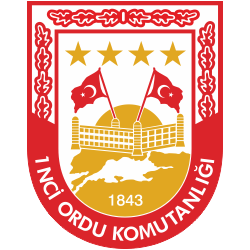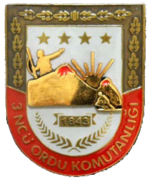A division is a large military unit or formation, usually consisting of between 6,000 and 25,000 soldiers.

A brigade is a major tactical military formation that typically comprises three to six battalions plus supporting elements. It is roughly equivalent to an enlarged or reinforced regiment. Two or more brigades may constitute a division.

The Italian Army is the land-based component of the Italian Armed Forces. The army's history dates back to the Italian unification in the 1850s and 1860s. The army fought in colonial engagements in China, Libya, Northern Italy against the Austro-Hungarian Empire during World War I, Abyssinia before World War II and in World War II in Albania, Balkans, North Africa, the Soviet Union, and Italy itself. During the Cold War, the army prepared itself to defend against a Warsaw Pact invasion from the east. Since the end of the Cold War, the army has seen extensive peacekeeping service and combat in Afghanistan and Iraq. Its best-known combat vehicles are the Dardo infantry fighting vehicle, the Centauro tank destroyer and the Ariete tank and among its aircraft the Mangusta attack helicopter, recently deployed in UN missions. The headquarters of the Army General Staff are located in Rome opposite the Quirinal Palace, where the president of Italy resides. The army is an all-volunteer force of active-duty personnel.

The First Army of the Republic of Turkey is one of the four field armies of the Turkish Army. Its headquarters is located at Selimiye Barracks in Istanbul. It guards the sensitive borders of Turkey with Greece and Bulgaria, including the straits Bosporus and Dardanelles. The First Army is stationed in East Thrace.

The Land Forces are the land forces of the Polish Armed Forces. They currently contain some 62,000 active personnel and form many components of the European Union and NATO deployments around the world. Poland's recorded military history stretches back a millennium – since the 10th century. Poland's modern army was formed after Poland regained independence following World War I in 1918.

The Iraqi Ground Forces, or the Iraqi Army, is the ground force component of the Iraqi Armed Forces. It was known as the Royal Iraqi Army up until the coup of July 1958.

The Battle of Sarikamish was an engagement between the Russian and Ottoman empires during World War I. It took place from December 22, 1914, to January 17, 1915, as part of the Caucasus campaign.

The Turkish Land Forces, or Turkish Army, is the main branch of the Turkish Armed Forces responsible for land-based military operations. The army was formed on November 8, 1920, after the collapse of the Ottoman Empire. Significant campaigns since the foundation of the army include suppression of rebellions in southeastern Turkey from the 1920s to the present day, combat in the Korean War, the 1974 Turkish invasion of Cyprus and the current Turkish involvement in the Syrian Civil War, as well as its NATO alliance against the USSR during the Cold War. The army holds the preeminent place within the armed forces. It is customary for the Chief of the General Staff of the Turkish Armed Forces to have been the Commander of the Turkish Land Forces prior to his appointment as Turkey's senior ranking officer. Alongside the other two armed services, the Turkish Army has frequently intervened in Turkish politics, a custom that is now regulated to an extent by the reform of the National Security Council. The current commander of the Turkish Land Forces is General Musa Avsever.
The Second Army of the Turkish Army has headquarters in Malatya. It protects Anatolia and it patrols the border with Syria, Iraq and Iran. Modern Turkish corps are referred to in TGS literature in Ottoman Turkish (1st) numerals. It is not clear when the change occurred. An arbitrary date of 1945 has been chosen as the point at which to start referring to corps in Ottoman Turkish numerals.

The Syrian Army, officially the Syrian Arab Army (SAA), is the land force branch of the Syrian Armed Forces. It is the dominant military service of the four uniformed services, controlling the most senior posts in the armed forces, and has the greatest manpower, approximately 80 percent of the combined services. The Syrian Army originated in local military forces formed by the French after World War I, after France obtained a mandate over the region. It officially came into being in 1945, before Syria obtained full independence the following year.

Royal Saudi Land Forces is the land warfare service branch of the Armed Forces of Saudi Arabia. It is part of the Ministry of Defense, which is one of the two military departments of the Government of Saudi Arabia, together with the Ministry of National Guard.

The Third Army was originally established in Skopje and later defended the northeastern provinces of the Ottoman Empire. Its initial headquarters was at Salonica, where it formed the core of the military forces that supported the Young Turk Revolution of 1908. Many of its officers who participated in the Revolution, including Enver Pasha and Mustafa Kemal Atatürk, rose to fame and power.

The IV Army Corps is an army corps of the Hellenic Army. Established before the First World War, it served in all conflicts Greece participated in until the German invasion of Greece in 1941. Re-established in 1976, it has been guarding the Greco-Turkish land border along the Evros River, and is the most powerful formation in the Hellenic Army.

The Bergmann Offensive was the first engagement of the Caucasus Campaign during World War I. General Georgy Bergmann, commander of the 1st Caucasus Army Corps, took the initiative against the Ottoman Empire.

The Comando Truppe Alpine or COMTA commands the Mountain Troops of the Italian Army, called Alpini and various support and training units. It is the successor to the 4º Corpo d'Armata Alpino of the Cold War. The Alpini are light Infantry units specializing in Mountain Combat. The subordinate units of the COMTA distinguished themselves during combat in World War I and World War II.
The First Army or First Guards Army of the Ottoman Empire was one of the field armies of the Ottoman Army. It was formed in the middle 19th century during Ottoman military reforms.
This is the order of battle of the Turkish Army in June 1941. The formation named 941-A Seferî Kuruluş was as follows:
The Eastern Front was one of the fronts of the Army of the Grand National Assembly during the Turkish War of Independence. Its commanded all military units in Eastern Region. At first, its headquarters was located at Erzurum, and moved to Sarıkamış, then Kars during the Turkish–Armenian War.
The 17th Rifle Corps was a corps of the Red Army and later the Soviet Army, formed three times.














